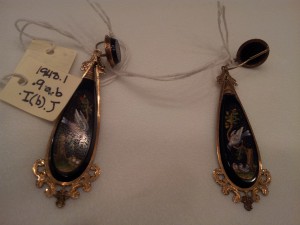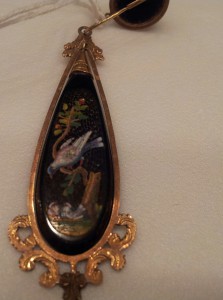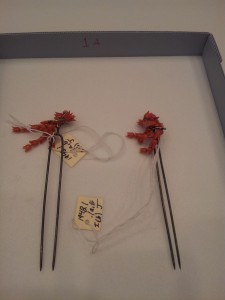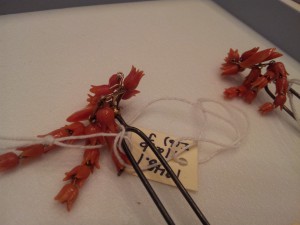Mount Holyoke College Art Museum, South Hadley, MA
The pieces of jewelry I chose to examine, cap pins and a pair of earrings, were among the many precious artifacts within the Art Museum’s collection. Oddly enough, both of the objects I chose were given to the college as a gift from Henrietta Franchois Fitzmaurice, a graduate of the class of 1896. They were given in memory of Esther C. Fitzmaurice and Sarah A. Start, class of 1852. It is believed that the earrings originated in Florence, somewhere between 1850-1860 but I’m not entirely sure. However, they are probably without a doubt from the mid-18th century, right at the heart of the Decadent literary movement. Although I can’t find specifics on the personal stories of these objects, they no doubt carried significant sentimental value in the very gesture of the gift giving. However, after having read various works from the 19th century throughout my Gendering Material Culture class, I can surmise with fairly enough certainty that both objects are heavily gendered towards the feminine.
Painted Drop-Shaped Earrings:
Probably Florentine. ca. 1850-1860. jet, gold. glass and stone (micro-mosaic)
Within the painted scene shown on the earrings, a mother bird(presumably) feeds her baby chicks. Everything about the image suggests the presence of spring, renewal and motherhood.
Throughout the ages of western imperialism, the obsession with controlling nature has been a common theme. With the change brought by the age of industrialization, for most of city-living society, time spent in nature was fairly limited. Therefore, fashion trends that depicted or featured scenes of nature could have been in homage to the exotic unknown.
According to Robert K. Liu, butterflies, “are almost universally regarded as beneficial and beautiful, and their images were incorporated into Egyptian bracelets as early as the IV dynasty (circa 2600 B.C.).”
Cap Pins:
Naples ca. 1845 carved coral, bronze, and gold
Although the cap pins do not carry heavily feminine symbols, after having read various literary works, such as Marchesa Colombi and Jolanda, for example, the “spillo” or pin, especially one that has dangly carved coral flower buds, was most likely intended for a female wearer. Hair pins, or hat pins in this case, usually made from silver or another precious material, was a way for both older and younger women to showcase their elegance, beauty, good breeding, and in the case of younger women, their readiness for courtship or marriage.




